|

One View of Mt. Fuji
by Brenda Sutton
[Image:"Red Fuji" and by Katsushika Hokusai
"Blazing Taimatsu Columns" and "Mikoshi" by Jonathan Smith]
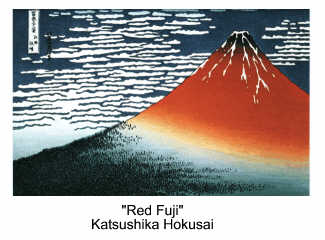 Does the road wind uphill all the way? Does the road wind uphill all the way?
Yes, to the very end.
Will the journey take the whole long day?
From morn to night, my friend.
— Christina Rossetti, 1867
When I was thirteen, my Navy pilot father announced that our next duty station was going to be Japan. Dad had done several tours of duty in the Orient, but hadn't taken the family along because the reputations of the miltary base schools weren't high. This situation improved, so we were going. I could finally travel beyond the borders of the United States. (In my mind, neither living in Kodiak, Alaska when it was still a territory nor visiting Tiajuana, Mexico on a day trip counted.) This would would be life in a foreign land, a romantic, mysterious, beautiful country very different from anything I'd ever experienced.
Over the years, my father had purchased most of our household furnishings from Japan; black teak wood tables, fragile rice-papered screens, ginger jar lamps, tatami mats, futon and zabaton pillows, macrame-covered fishing globes, and several porcelain figures depicting life in a Japanese village. We wore colorful haori (short cotton kimonos) and white tabi socks (mitten-like slippers). 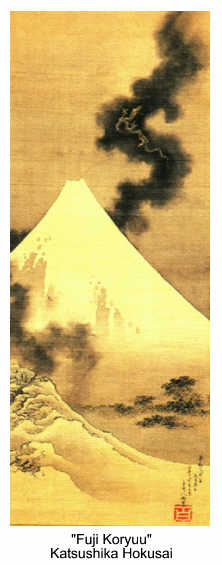 He taught us to use chop sticks not long after we learned how to hold a fork, and my mother learned Oriental cooking from one of our neighbors, a Japanese woman who'd married an American sailor. Everything Japanese that came within my small scope seemed beautiful and aromatic and fine. With great anticipation, I started studying Japanese from a set of six records. I was well into the third LP when my parents broke the news to us of their pending divorce. It shattered my life in ways that all children's lives are shattered when their parents separate, but I felt an extra loss when my father flew off to Japan, and we remained behind on Whidbey Island, Washington. I stopped studying Japanese, but I never stopped yearning for that far away place. He taught us to use chop sticks not long after we learned how to hold a fork, and my mother learned Oriental cooking from one of our neighbors, a Japanese woman who'd married an American sailor. Everything Japanese that came within my small scope seemed beautiful and aromatic and fine. With great anticipation, I started studying Japanese from a set of six records. I was well into the third LP when my parents broke the news to us of their pending divorce. It shattered my life in ways that all children's lives are shattered when their parents separate, but I felt an extra loss when my father flew off to Japan, and we remained behind on Whidbey Island, Washington. I stopped studying Japanese, but I never stopped yearning for that far away place.
Years later I was rummaging through boxes of books at a "Fill a Bag for a Buck" library sale. There, under stacks of mildewed cast-offs, I found a volume called Fugaku Sanju Rokkei (Thirty-six Views of Mt. Fuji). How that beautiful jewel could ever have wound up amongst such rubbish, I'll never know. Mine! The artist, Katsushika Hokusai, spent his life from 1760 to 1849 capturing the mountain from every angle, in all seasons, and with such delicate beauty and power. My husband also enjoyed the book when we married, and I've treasured it ever since.
In 2004, the city of Yokohama won the bid for the 65th World Science Fiction Convention which will be taking place this September. It seemed a rather blatant poke in the back to us from the Gods. "Here you've been wanting to see Japan your whole life long. You should go." The thing about the Gods is that they rarely fulfill the same wish twice. Either recognize that the desire of your heart is being granted, or understand that you must want something else even more — so, we're going.
With the opportunity to finally travel to Japan, the one thing that both of us wanted to accomplish was a pilgrimage to Mount Fuji. It would take far longer than we have to see all of Hokusai's many views, which after the initial thirty-six continued to one hundred images. Then we learned of this pathway up the mountain many make every day during climbing season. We checked our timing, and, as luck would have it, the season ends two days after we arrive. Past that time, the weather threatens travelers, making the trail too dangerous, so it is closed from mid-September until spring. (Fortunately for me, the Meiji government lifted the Shinto ban on women climbing Mount Fuji in 1872 to avoid Western criticism for their upcoming Philadelphia World Exposition in 1876. Until that time it was believed that the Goddess would become explosively jealous of women walking on Her mountain — not a good thing when the Goddess is a volcano.) (Fortunately for me, the Meiji government lifted the Shinto ban on women climbing Mount Fuji in 1872 to avoid Western criticism for their upcoming Philadelphia World Exposition in 1876. Until that time it was believed that the Goddess would become explosively jealous of women walking on Her mountain — not a good thing when the Goddess is a volcano.)
I assure you, neither my husband nor I are in the best of physical shape, but we've been walking two miles every day wearing our hiking boots and back packs to try to prepare. There's a big difference, I'm sure, between traveling this distance on flat Indiana ground, and climbing ten times this distance up the side of a dormant volcano. We're only going to carry the very least we can get away with: trousers with zip-off legs for the bottom of the trail that is hot, and extra layers for the top, where it will be 30 degrees or so; water bottles; energy snack bars; bandages for the inevitable blisters; gloves for the rocky incline; and plastic bags to carry out our trash, as there are no garbage bins on the mountain (and rightly so!). We'll probably purchase these small oxygen cannisters you can get at Station Five and higher, where the air starts getting a little thin. You can also reserve a lunch there. Many pilgrims choose to take a bus to Station Five, and start their climb from halfway up the mountain. Somehow the idea of skipping half the climb seems a rather false sort of sacrifice. We have decided to choose sturdy walking sticks and begin our venture at the bottom of the mountain. For $11 a burn, brasier kiosks all the way up the mountain will brand the stick with a symbol to show how high you were able to climb. (I plan to take a handy Zippo lighter and make my own mark.)
If you are able to climb to Station Eight by 10 pm, there are traveler's huts where you can get a meal and rest on a cot. Attendants waken you at midnight to climb the rest of the way to the summit. There, from the top of Japan, is the climax to the pilgrimage — enjoying the sunrise from the peak of the mountain. Then we'll be walking ever so carefully back down the mountain to the village of Fuji-Yoshida to a hot bath for our aching feet, and a celebration we will always remember of our feat.
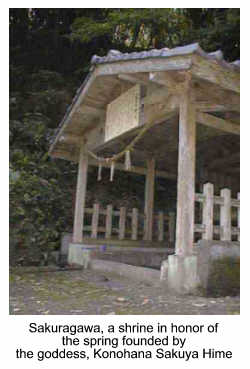 The name of the mountain comes from the Ainu word for "fire". A shrine was dedicated to the Goddess in 806 A.D., but that didn't prevent Fuji-san from erupting violently in 864. The fiery Goddess later evolved into the more peaceful Konohana Sakuya Hime, Princess of the Flowering Trees, from which derives the word sakura (cherry blossom). The first written record of Her story is found in the Kojiki, the oldest surviving book in Japan, a compilation of Japanese mythology writen in the 8th century A.D. The name of the mountain comes from the Ainu word for "fire". A shrine was dedicated to the Goddess in 806 A.D., but that didn't prevent Fuji-san from erupting violently in 864. The fiery Goddess later evolved into the more peaceful Konohana Sakuya Hime, Princess of the Flowering Trees, from which derives the word sakura (cherry blossom). The first written record of Her story is found in the Kojiki, the oldest surviving book in Japan, a compilation of Japanese mythology writen in the 8th century A.D.
Is the story of this Goddess, Her husband grew suspicious when, shortly after their wedding, She became pregnant. To prove Her fidelity, Konohana Sakuya Hime declared, "If my baby is truly your child, I shall deliver safely." She then entered a bower, set it alite, and miraculously gave birth to not just one son, but three — triplets — all unscathed by the flames. The annual fire ceremony at Fuji-Yoshida, which begins the day we walk down the mountain, recalls this story as a means of protecting the town from fire and promoting easy childbirth. Other legends of Konohana Sakuya Hime are important to the Koyu-gun district where She established a hot spring to bathe Her children (koyu is a combination of words meaning "hot water" and "child".) Because She couldn't produce enough milk to feed all three boys, the Goddess invented sake, the delicious fermented rice wine enjoyed thorughout Japan. I fully intend to pray at Her temple for a safe journey, and raise my sakezuki (cup) to toast Her honor at its completion.
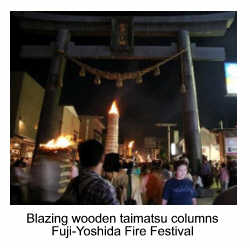 Konohana Sakuya Hime originally had little connection with Mount Fuji. Sometime between the 14th and 16th centuries, the people who lived at the foot of the mountain began petitioning the Goddess for protection from eruptions of the volcano, as She had protected the newborn princes from the flames of the burning bower. Between 1600 and 1868, the Shinto Fuji mountain-climbing movement called the Fuji-ko claimed Konohana Sakuya Hime as the principal Goddess of their sacred mountain. You can find Her as the central deity in major Shinto shrines from the base of the volcano to the rim of its crater. Members of the Fuji-ko worship the Goddess at altars in their homes, and each group will be lighting a torch in Her honor at the Fuji-Yoshida fire ceremony. At this annual celebration a representation of the Goddess is reverently taken from the temple and reenshrined in a palanquin called a mikoshi. Konohana Sakuya Hime originally had little connection with Mount Fuji. Sometime between the 14th and 16th centuries, the people who lived at the foot of the mountain began petitioning the Goddess for protection from eruptions of the volcano, as She had protected the newborn princes from the flames of the burning bower. Between 1600 and 1868, the Shinto Fuji mountain-climbing movement called the Fuji-ko claimed Konohana Sakuya Hime as the principal Goddess of their sacred mountain. You can find Her as the central deity in major Shinto shrines from the base of the volcano to the rim of its crater. Members of the Fuji-ko worship the Goddess at altars in their homes, and each group will be lighting a torch in Her honor at the Fuji-Yoshida fire ceremony. At this annual celebration a representation of the Goddess is reverently taken from the temple and reenshrined in a palanquin called a mikoshi.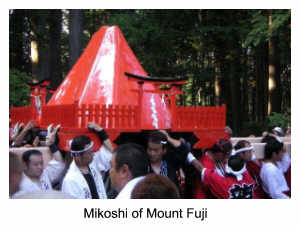 She is then boisterously processed around the village, showing Her the homes and businesses, and introducing her to all of Her people. She is accompanied by another large mikoshi in the shape of a large red Mount Fuji. The streets are lined with 70 taimatsu wooden columns each 3 meters high that are set ablaze. If done properly, it is hoped that She will not allow the volcano to erupt and destroy the village. Then there are two days of bonfires, eating, dancing, games, and paati (Japanese borrowed English for whoopty doo). She is then boisterously processed around the village, showing Her the homes and businesses, and introducing her to all of Her people. She is accompanied by another large mikoshi in the shape of a large red Mount Fuji. The streets are lined with 70 taimatsu wooden columns each 3 meters high that are set ablaze. If done properly, it is hoped that She will not allow the volcano to erupt and destroy the village. Then there are two days of bonfires, eating, dancing, games, and paati (Japanese borrowed English for whoopty doo).
I'm so excited...and a little nervous...about this trip. I had a hard time climbing Kennesaw Mountain, and it's nowhere near as high as Mount Fuji. Phil Cousineau says in his book, The Art of Pilgrimage, that "when travel is too easy, people often don't appreciate their experience and certainly don't understand the mythological nature of certain kinds of travel." There will be nothing easy about this journey for me, but this is my lifelong-awaited pilgrimage, so I'm going to try.
References:
- Calza, Gian Carlo, Hokusai
 , Phaidon Press; New Ed edition (October 1, 2004) , Phaidon Press; New Ed edition (October 1, 2004)
- Cousineau, Phil, The Art of Pilgrimage: The Seeker's Guide to Making Travel Sacred
 , Conari Press, April 2000 , Conari Press, April 2000
- Ishii, Toun, Fuji San: Enchanting Mountain
 , Books Nippon, May 1989 , Books Nippon, May 1989
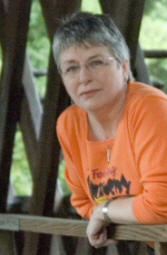 Brenda Sutton is the publisher of Mythic Passages, Operations Director, Corporate Secretary, and Office Administrator for Mythic Imagination Institute. She is an award-winning singer/songwriter with the internationally reknown band Three Weird Sisters. She works in a support and consultant capacity for the non-profit music organization Interfilk, and maintains their website. She is freelance writer whose work has appeared in newspapers and magazines. She is also the mother of five, grandmother of two.
Brenda Sutton is the publisher of Mythic Passages, Operations Director, Corporate Secretary, and Office Administrator for Mythic Imagination Institute. She is an award-winning singer/songwriter with the internationally reknown band Three Weird Sisters. She works in a support and consultant capacity for the non-profit music organization Interfilk, and maintains their website. She is freelance writer whose work has appeared in newspapers and magazines. She is also the mother of five, grandmother of two.
Return to Passages Menu
Subscribe to the Passages e-zine
|

